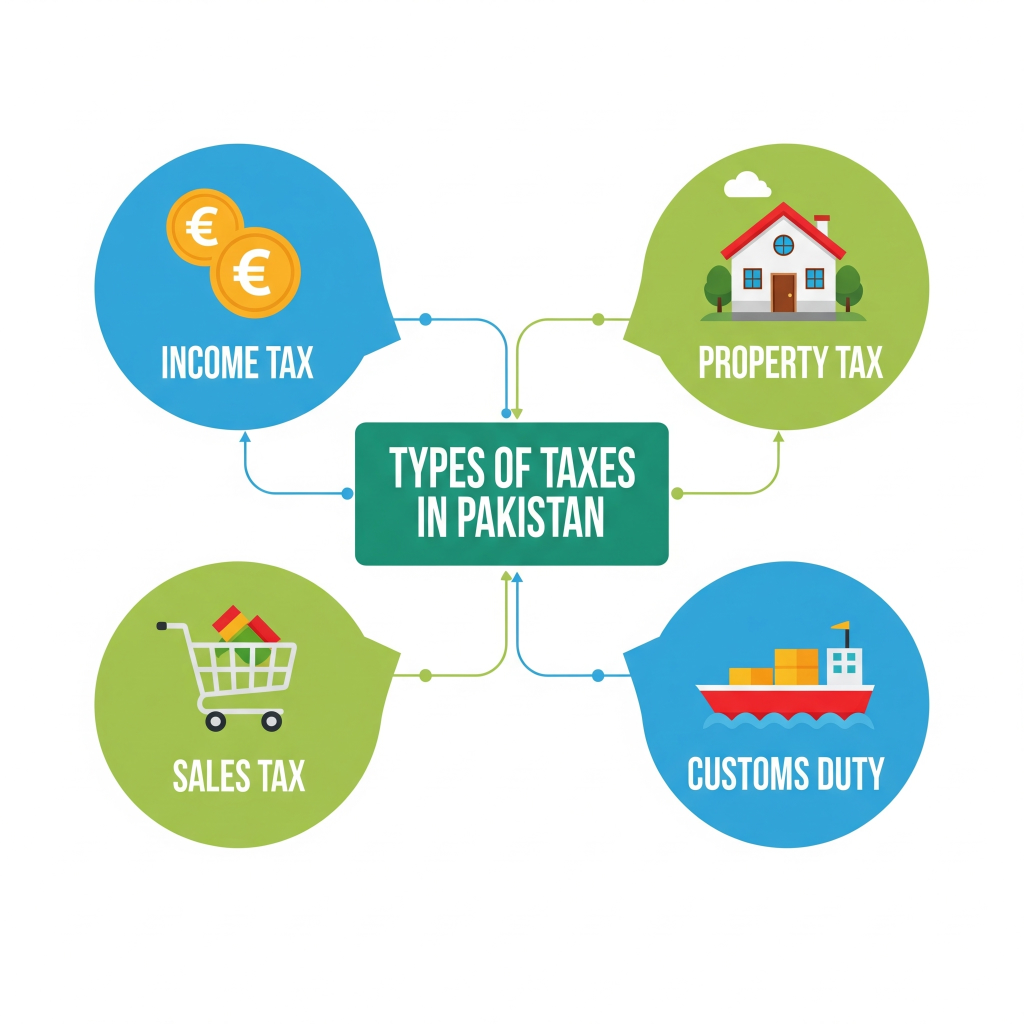📘 Comprehensive Guide to Types of Taxes in Pakistan
Taxation in Pakistan serves as the backbone of government revenue, funding essential services like healthcare, education, infrastructure, and defense. It is also a key instrument for wealth redistribution and economic regulation. The Federal Board of Revenue (FBR) administers most federal taxes, while provincial governments collect taxes under their jurisdiction.
Pakistan’s tax structure broadly consists of direct taxes (paid on income, profits, and assets) and indirect taxes (paid through consumption of goods and services). Below is a detailed breakdown of the different types of taxes in Pakistan.
1️⃣ Direct Taxes
Direct taxes are levied directly on individuals and organizations, based on their income, wealth, or assets. These cannot be shifted to another party.
A. Income Tax
Who Pays? Salaried individuals, businesses, corporations, and other entities with taxable income.
Tax Slabs (FY 2024–25 for Salaried Individuals):
-
Up to PKR 600,000 → 0%
-
PKR 600,001 – 1,200,000 → 2.5%
-
PKR 1,200,001 – 2,400,000 → 12.5%
-
PKR 2,400,001 – 3,600,000 → 20%
-
PKR 3,600,001 – 6,000,000 → 25%
-
Above PKR 6,000,000 → 35%
Corporate Tax Rate: 29% for most companies (special rates apply to banks, insurance, and other sectors).
Advance Tax: Deducted at source on various transactions such as cash withdrawals, vehicle registration, and property purchases.
B. Property Tax
Levied on immovable property including houses, land, and commercial buildings.
Collected by local governments such as Cantonment Boards and Municipal Corporations.
Rates vary by property value and location.
C. Capital Gains Tax (CGT)
Applies to profits from the sale of assets such as real estate, stocks, and bonds.
On real estate: 0–15% depending on the holding period.
On stocks: 12.5–15% if held for less than one year.
D. Withholding Tax (WHT)
Collected at source to ensure early collection of revenue. Examples include:
-
Salaries (as part of payroll tax)
-
Dividends (15%)
-
Bank interest/profit (10–15%)
-
Contractual payments (6–8%)
2️⃣ Indirect Taxes
Indirect taxes are included in the price of goods and services. These are ultimately borne by consumers.
A. Sales Tax
Standard rate is 18% on most goods and services.
Exemptions include basic food items, healthcare, and education.
Provincial Sales Tax applies on certain services such as restaurants, hotels, telecom, and transport (e.g., Sindh Sales Tax on Services).
B. Federal Excise Duty (FED)
Applied to specific goods and services, particularly luxury or harmful products.
This includes cigarettes, beverages, automobiles (based on engine capacity), as well as air travel and telecom services.
C. Customs Duties
Levied on imported goods with rates ranging from 0% to 80%.
Regulatory Duty (RD) is imposed on non-essential imports to discourage luxury spending.
Additional Customs Duty (ACD) adds further charges on selected items.
D. Value Added Tax (VAT) – Proposed
While Pakistan primarily uses a sales tax system, discussions around implementing VAT continue as it would broaden the tax base and reduce loopholes.
3️⃣ Provincial Taxes
Under the 18th Amendment, provinces have the authority to levy their own taxes. Key provincial taxes include:
-
Agricultural Income Tax: On farm income, though often under-enforced.
-
Professional Tax: Paid annually by professionals such as doctors, lawyers, and consultants.
-
Motor Vehicle Tax: Annual fee based on vehicle engine capacity.
-
Stamp Duty: Charged on property transactions and legal documents, usually 1–3% of property value.
4️⃣ Other Taxes & Levies
Workers Welfare Fund (WWF): 2% imposed on certain industries.
Workers Profit Participation Fund (WPPF): 5% of company profits shared with workers.
Advance Income Tax (AIT): Collected through electricity, gas, and telecom bills.
🚧 Challenges in Pakistan’s Tax System
Pakistan faces significant hurdles in effective tax collection.
-
Low Tax-to-GDP Ratio: Around 10%, one of the lowest in South Asia.
-
Tax Evasion & Informal Economy: Only around 3 million active filers out of 240+ million people.
-
Complex Procedures: Cumbersome compliance discourages individuals and businesses.
-
Federal-Provincial Overlaps: Lack of coordination leads to inefficiencies and double taxation risks.
✅ Conclusion
Pakistan’s taxation system is a blend of direct and indirect taxes, supplemented by provincial levies. While efforts such as digitization, online portals, and schemes like Tajir Dost aim to increase compliance, challenges like weak enforcement, tax evasion, and complexity still persist.
For individuals and businesses, understanding the types of taxes and their rates is crucial for compliance, financial planning, and avoiding penalties. With stronger enforcement, simplification of procedures, and better awareness, Pakistan can improve its tax base and create a fairer system that funds national development effectively.

